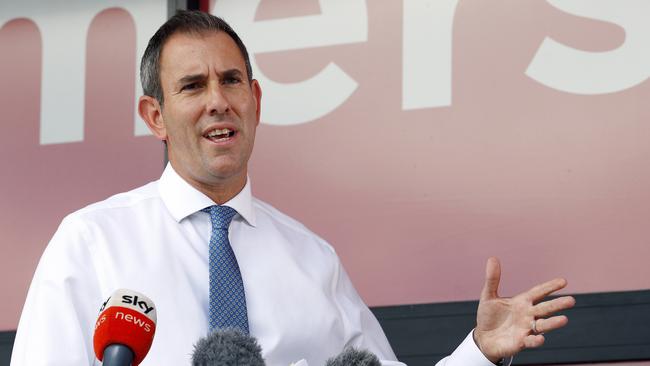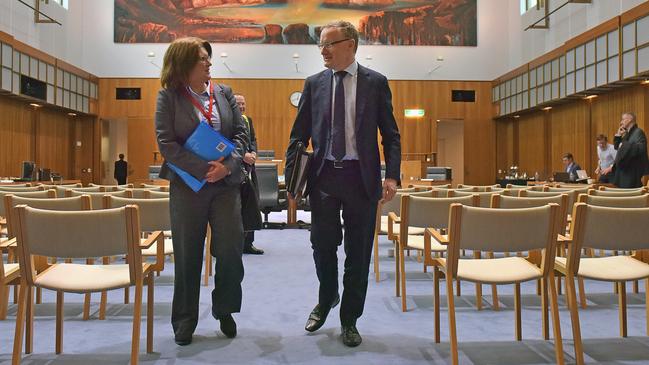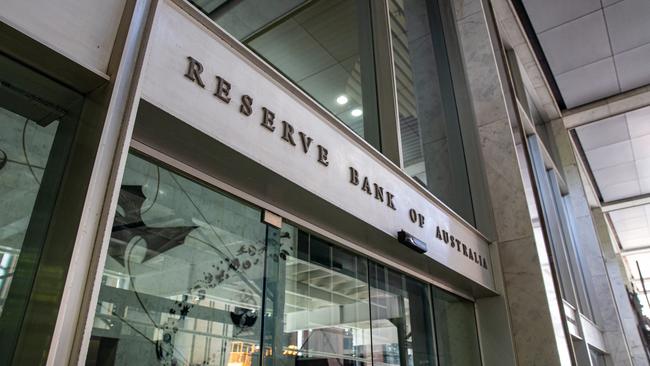RBA’s Philip Lowe ‘misjudged mood’ in private meeting with Barrenjoey


To get there Lowe will first need to negotiate the pack of paparazzi that have been camped out the front of his Sydney house for the past month. He has also found less-than-convincing support from Treasurer Jim Chalmers as the RBA navigates some of the most complicated economic waters of the past few decades.
Chalmers will make a decision in coming months on whether to renew Lowe’s term for up to seven years. Helping his decision will be the findings of a review of the central bank, which is nearing completion. Anthony Albanese’s outer ministers already see Lowe, appointed by then treasurer Scott Morrison in 2016, as a convenient scapegoat for soaring household costs.
Given the current cranky mood of an electorate facing rising inflation and mortgage repayments, Lowe is on track to become the first governor since Bernie Fraser to hold just a single term. And with the top ranks of the RBA thin or new to the role, this puts Australia a step closer to recruiting someone offshore for its next central bank governor.

Lowe’s fate was likely sealed last Thursday when he attended a private lunch at investment bank Barrenjoey. The meeting has given more fuel to the burning resentment around the central bank, particularly its approach to communications, where Lowe has been accused of dropping the ball.
An RBA spokeswoman said: “The bank regularly speaks to businesses, markets and other community groups throughout the year. The governor reiterated what was in the post-board meeting statement, and was there to listen to the views of others.”
It is entirely normal for RBA officials to meet with the market and private economists, particularly following rate decisions, to explain their thinking. Over the past three months Lowe has held private meetings with investment bank UBS, Nomura, ANZ, Flagstaff Partners, credit card giant Visa, Harry Triguboff’s Meriton, the Australian Council of Social Service, small-to-mid-sized business lender Judo Bank as well as journalists from multiple publications, including The Australian.
Going back further last year there were dozens more private meetings including with Commonwealth Bank, NAB, academics, businesses from western Sydney, Victorian Premier Dan Andrews and opposition Treasury spokesman Angus Taylor. However, on this occasion the optics of the Barrenjoey meeting are terrible. At best, it is a misjudgment by the RBA.
Deputy RBA governor Luci Ellis was scheduled to hold a briefing with Barrenjoey in Melbourne this Wednesday, but over the weekend it was cancelled at the request of the RBA.
Hawkish stance backed
Last Tuesday’s interest rate hike to 3.35 per cent saw the central bank moving to hawkish footing – that is, shifting to a much more aggressive position on future rate rises in order to tackle inflation.
Usually, post-RBA decision briefings are handled by the RBA’s deputies, so Lowe’s briefings, particularly at this time of year, were unusual.
The timing of Thursday’s lunch with Barrenjoey staffers and their clients, including traders from the big four banks, came before the Statement of Monetary Policy, or SoMP, was released on Friday. The SoMP, issued quarterly, provides the colour – important for economists – around the bank’s views.
While top-line forecasts were unchanged, the latest SoMP did make some key tweaks around some of its more detailed forecasts. In particular, it lifted the starting point for December quarter underlying inflation, which prompted the RBA to lift the glide path of underlying inflation. Here the central bank cited second-round effects from higher energy prices and a lift in domestic labour cost growth as factors. In effect, the SoMP reinforced the RBA’s hawkish stance.

Those inside the Reserve Bank point out any market-sensitive information was contained in Tuesday’s cash rate decision statement, including forecasts on inflation, unemployment and growth. They also strongly dispute any forward guidance on the cash rate was issued at the Barrenjoey meeting. Barrenjoey declined to comment.
A senior trader from one big four bank on Sunday pointed out Australian 3-year bonds were being sold off sharply from early Thursday morning (which in turn pushed up yields) in the midst of a highly volatile week on global money markets, including a heightened US cash rate outlook. The sale of the bonds is consistent with a hawkish outlook.
Most of the 3-year pricing falls losses took place before 12.30pm, although two large blocks of the bonds were traded in the early afternoon.
Chalmers on Sunday told ABC’s Insiders how Lowe manages his diary is a matter for the RBA, but there was “a broader issue about how the bank communicates the context for its decisions”.
Chalmers said this is a regular topic of discussion with the Reserve Bank Review Panel, which is under way, and it again came up as a topic for discussion last Friday. The panel, led by former Bank of Canada deputy governor Carolyn Wilkins, is scheduled to deliver its report to Chalmers by the end of March.
The highly regarded Wilkins will be one to watch as the government considers alternatives to Lowe.
Chalmers has previously said he is expected to finalise his decision on another term for Lowe by the middle of the year and will take soundings from cabinet colleagues. In the meantime, interest rates will move higher and the economy is expected to start reacting by slowing sharply.
Dangerous territory
As a career central banker, Lowe has spent a lifetime learning how to be guarded. Top central bankers are schooled over decades around the art of communicating while giving away very little, and Lowe is no exception.
However, over his near seven-year term Lowe has attempted to increase the frequency of communication, including speeches and questions. He has introduced live broadcasts of speeches and appearances through the RBA’s website.
After a speech in 2019 in the NSW town of Armidale, organised by the local business chamber, Lowe stayed until the room had exhausted its questions (including one from Barnaby Joyce), which ran for more than an hour and covered issues from climate change and banks behaving badly to excessive CEO pay. However, one area where Lowe has resisted is the practice of holding a regular press conference after a board meeting, such as the Bank of England or US Federal Reserve.

Still, this year Lowe opted against a speech after the February board meeting – the first of the year – something he has delivered to the National Press Club since 2019. He believed the upcoming double parliamentary hearings would serve as appropriate public forums. He also knocked back the idea of a press conference following last Tuesday’s rates decision. Press conferences to announce cash rate moves are rare in Australia, instead held during significant economic turning points, and Lowe felt it would send the wrong message.
Whatever the reasons, for outsiders it still looks like the RBA boss has given a selective briefing to a privileged few before explaining his position to the Australian public. That comes after interest rates have been hiked at the fastest pace in decades.
Liberal senator Andrew Bragg, deputy chair of the Senate economics committee, said Lowe will be asked about the meeting but the bigger question is around inflation and whether the Albanese government is adding to inflation by talking up economic stimulus packages and spending any tax windfalls.
“The government has to pull its weight in fighting inflation,” Bragg said. “They haven’t given any indication that they’re willing to support what the RBA is trying to achieve.”
Backlash
The growing backlash against Lowe and increasing doubts around his reappointment put economic policymaking into dangerous political territory. It reflects poorly on Chalmers, who is also responsible for protecting the RBA’s independence. Just last week, Assistant Treasurer Stephen Jones made a bad error by signalling that the course of rate rises already in the system should be enough to cool inflation. Treasury ministers should never give their view on future rate moves.
Be it Lowe or anyone else in the seat, Australia still would have been forced to hike official cash rates quickly as inflation spread around the world, including here. For Australia to hold on to an ultra-loose cash rate policy, as union leaders have been advocating, would crash the currency and risk sending inflation deep into double-digit territory.

Indeed, Australia’s 3.35 per cent cash rate sits well below others including the UK, US and New Zealand, but ahead of the European Central Bank at 3 per cent. Canada, often pointed to as a model for the RBA to follow, has a cash rate of 4.5 per cent.
The biggest criticism aimed at Lowe has been around communication and his issuing of forward guidance, promising rates would stay rock bottom until 2024. But Lowe was doing what all central bankers do – jawboning. In that case it was to spur confidence for people to borrow during the Covid shock. Anyone who takes out a 25-year mortgage based on three years of low rates guidance probably needs a financial health reality check. And what was meant to happen after 2024 when rates went up anyway.
Lowe is at it again with the jawboning, this time trying to change the behaviour of households as he talks tough around hiking rates much harder than what he probably will end up doing. The central bank boss is trying to engineer a soft landing for an economy still running hot. Apart from savers, few will complain if the cash rate starts to ease, which could happen as early as next year. By then it will all probably be too late for Lowe. On the current mood, it is likely to be some other governor’s economy to manage.
johnstone@theaustralian.com.au




It’s going to be a rough few days for embattled Reserve Bank governor Philip Lowe, who faces two separate rounds of parliamentary hearings in Canberra to explain why interest rates are likely to move even higher.